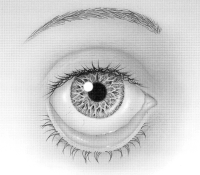Eyelid Surgery

Eyelid surgery can refer to many kinds of surgery involving the eyelid. It can be a term that describes functional blepharoplasty such as lids so baggy they weigh the upper eyelid down or hang over the lid margin and block vision. This situation is usually covered by insurance. Blepharoplasty done in the context without insurance is also referred to as cosmetic eyelid surgery. The surgery is done without insurance because either the eyelid skin does not weigh the lid down to block the vision or the patient plan does not cover blepharoplasty.
Eyelid surgery that involves the lid margin drooping over the pupil is referred to droopy eye lid surgery or ptosis repair. This too is commonly covered by insurance because the eyelid droop affects vision. For more information on blepharoplasty and ptosis repair see the previous sections devoted exclusively to these topics.
Eyelid laxity is a very common problem and is associated with the eyelid margin turning in or out. This most commonly occurs in the lower lid.
Sometimes eyelid surgery is done in conjunction with lid retraction or the lid being pulled downward in the case of the lower lid or upward as in the case of upper lid. This occurs usually as a result of scarring or nerve damage such as seventh nerve palsy. The scarring can be the result of excessive sun damage, burn, tumor, trauma or previous surgery. Seventh nerve palsy can occur spontaneously as a result of trauma or tumor such as an acoustic neuroma. Patients with VII nerve palsy have trouble closing their eyelids together. This can be treated with a Gold weight implant in the upper eyelid and a horizontal shortening of the lower eyelid because of the lack of innervation and subsequent laxity.
Eyelid surgery is sometimes needed in the case of trauma. It is important in trauma to repair the tarsus or skeleton of the eyelid to prevent notching. It is always important to identify damage to the levator and the lacrimal drainage system so these structures can be dealt with at the time of repair.
Eyelid surgery to reconstruct the eyelid to its normal appearance is necessary after tumor excision. Indications for tumor excision include any of the following: distortion of the lid margin, the loss of lashes, history of growth or pigmentation change. The tumors are excised by either frozen section monitoring, Mohs excision, or just straight excision. All these techniques use a pathologist to make sure the excision is complete. In the reconstruction of the eyelid, we use the same precautions as we do when dealing with trauma. For more information, see the section on eyelid cancer.
